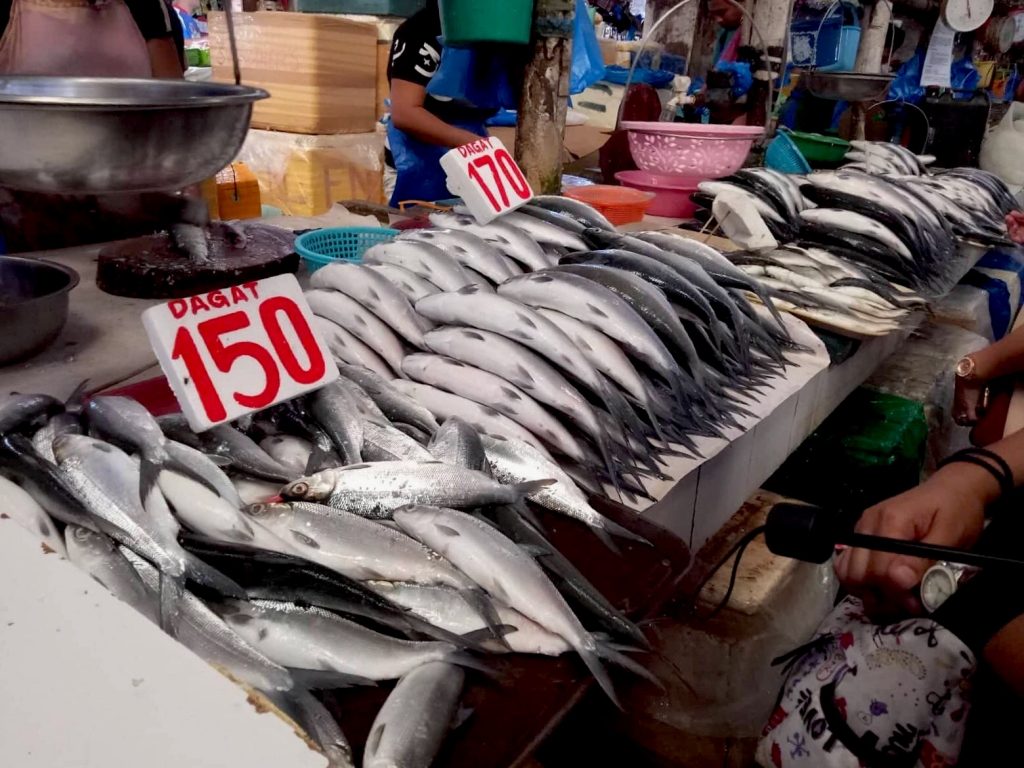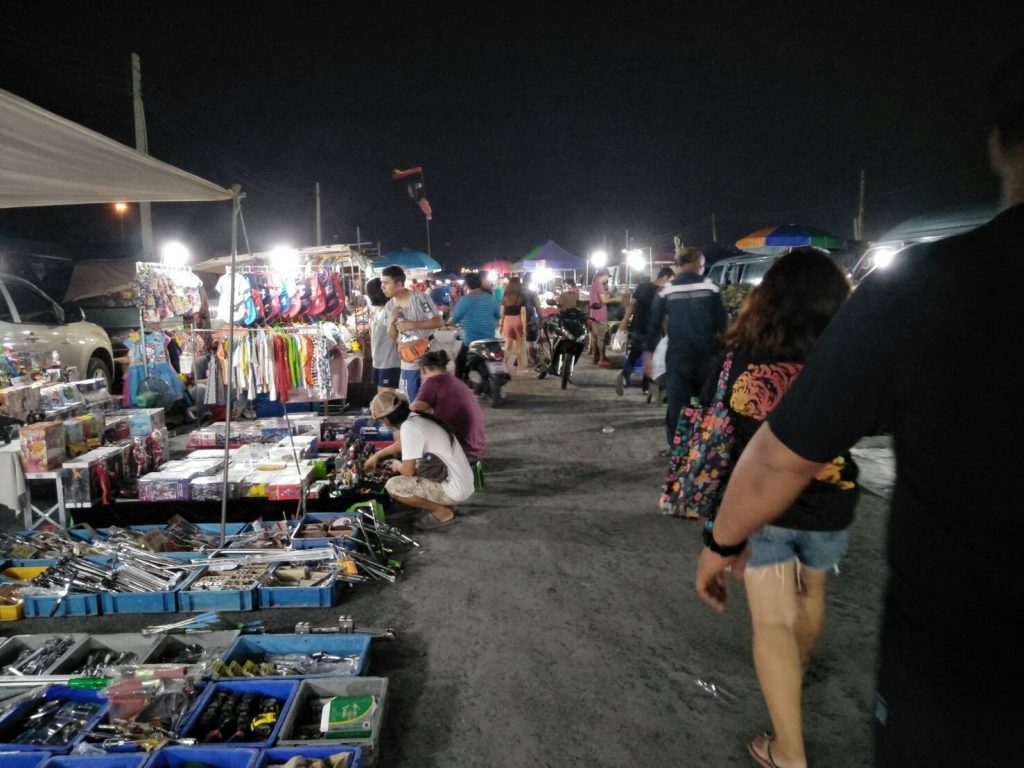៦០០០០រៀល! មើលទៅបង! បង្កងធំៗណាស់! || 60,000 KHR. Big ones! Look at them, sister!

April 25, 2019
The following story is written and self-translated by Cambodian writer Phina So, documenting a walk through Phsa Chhouk Meas | Golden Lotus Market in Phenom Penh.
Jump down to read the English version here.
ម្តាយរបស់ខ្ញុំបានត្រលប់មកពីផ្សារវិញទៅហើយ នៅពេលខ្ញុំភ្ញាក់ពីដំណេក។ បន្ទាប់ពីចេញទៅធ្វើការនៅខេត្តសៀមរាបអស់ប្រាំថ្ងៃ ខ្ញុំចង់ជួយការងារខ្លះដល់គាត់។ អ៊ីចឹងខ្ញុំក៏សួរ៖ «ម៉ាក់ តើមានអ្វីឱ្យខ្ញុំជួយទិញបន្ថែមទេ?»។ គាត់ក្រឡេកមើលខ្ញុំ ទាំងដៃនៅកាន់ស្លាបព្រា និងមានចានបបរ ដែលគាត់បានទិញពីផ្សារមុននេះបន្តិច។ គាត់ឆ្លើយ «អឺ…បើអ៊ីចឹង…ប្រហែលទិញបង្កង? ម៉ាក់ចង់ធ្វើសម្លម្ជូរយួនថ្ងៃនេះ។ បង្កងត្រូវម៉ាច់ជាមួយសម្លនេះតែម្តង!»។
ខ្ញុំដឹងពីបញ្ហាមួយ។ ក្រោយពីស្តាប់គាត់ គឺថា៖ គាត់មិនមែនភ្លេចទិញបង្កងអី្វនោះទេ គឺទំនងជាគាត់មិនហ៊ានទិញច្រើនជាង ដោយគាត់បារម្ភថា លុយដែលខ្ញុំជូនគាត់ប្រចាំខែ នឹងឆាប់អស់ បើគាត់ទិញអាហារថ្លៃៗ ដូចជាបង្កងជាដើម។
តាមពិតទៅ គាត់មិនមែនប្រាប់ឱ្យខ្ញុំទិញតែបង្កងទេ។ គាត់ប្រាប់ខ្ញុំទិញបីយ៉ាង៖ ទីមួយ គឺបង្កង, ទីពីរគឺម្នាស់ ព្រោះវាជាបន្លែសំខាន់សម្រាប់សម្លម្ជូរយួន ប៉ុន្តែគាត់ប្រាប់ថា ឱ្យខ្ញុំសម្រេចថាទិញ ឬមិនទិញ ព្រោះគាត់ខ្លួនឯង មិនចូលចិត្តម្នាស់។ ទីបី គឺផ្កាស្នោ ទុកហូបជាអន្លក់សម្រាប់អាហារពេលល្ងាច។
កូនស្រីអាយុ៩ឆ្នាំបានសុំទៅជាមួយខ្ញុំ។ ពេលខ្ញុំកាន់ដៃនាងដើរសំដៅទៅផ្សារ ខ្ញុំបានចាប់ភ្លឹក នឹកគិតអំពីសម្លម្ជូរយួន ព្រោះថ្មីៗនេះ ពាក្យ «យួន» ត្រូវបានគេលើកមកពិភាក្សាអំពីអត្ថន័យ និងប្រភពរបស់វា។ សម្រាប់ភាសាខ្មែរ ពាក្យ «យួន» គឹសំដៅលើជនជាតិវៀតណាម។ បើទោះជាខ្ញុំមិនច្បាស់លាស់នឹងអត្ថន័យពិតរបស់វា តែមានការជជែកដេញដោល ភាគច្រើនលើកឡើងដោយលោកខាងលិច ដែលថាពាក្យមួយនេះ ជាពាក្យបែបមើលងាយ និងរើសអើងជាតិសាសន៍។ ដល់អ៊ីចឹងទៅ ប្រជាជនកម្ពុជាមួយចំនួន រាប់ទាំងខ្ញុំដែរ បានដូរភាសា និយាយពី «សម្លម្ជូរយួន» មក «សម្លម្ជូរវៀតណាម» ជំនួសវិញ។
គំនិតនេះបានធ្លាយទៅបន្លែផ្សេងទៀតនៅឯផ្សារ។ ខ្ញុំគិតអំពី តើគេដាក់ឈ្មោះបន្លែ និងទីកន្លែង
ផ្សេងៗ ដោយផ្អែកទៅលើអ្វី? តើឈ្មោះទាំងនោះ ធ្លាប់មានគេប្រកែកតវ៉ាទេ ឬក៏ធ្លាប់មានគេប្តូរឈ្មោះវិញ ដោយប្រការផ្សេងៗទេ? ឬក៏ខ្លះមានឈ្មោះ ដែលគេប្រើដោយមិនចាំបាច់គិត? ឬមួយ មានឈ្មោះខ្លះ មានគេប្រើដែរ តែប្រើដោយប្រយ័ត្នប្រយែង?
ខ្ញុំបានគិតដល់ភាសាខ្មែរសម្រាប់ «ខ្ទឹមបារាំង»។ ជាទូទៅ ឱ្យតែបន្លែ ផ្លែឈើណារាងធំៗ យើងច្រើនដាក់ឈ្មោះវា ដោយភ្ជាប់ទៅនឹងពាក្យ «បារាំង»។ ខ្ញុំមិនច្បាស់សោះថា តើគេដាក់ឈ្មោះវា ដោយសារគេប្រៀបធៀបមាឌជនជាតិបារាំង នឹងមាឌជនជាតិខ្មែរ? ឬក៏ខ្ទឹមបារាំងមានប្រភពពីប្រទេសបារាំង? មិនមែនមកពីប្រទេសចិនទេឬ? ឬក៏បារាំងបានយកខ្ទឹមបារាំងនេះមកស្រុកខ្មែរក្នុងអំឡុងពេលអាណានិគម?
ម្នាស់ ដែលម៉ាក់មិនសូវចូលចិត្តនោះក៏អ៊ីចឹងដែរ។ ម្នាស់មានសម្បកក្រាស់នៅខាងក្រៅ។ នៅពេលចិតសម្បកនោះចេញ គេនឹងឃើញសាច់ខាងក្នុងមួយដុំៗ មើលទៅដូចភ្នែកអ៊ីចឹង។ ពាក្យថា «ភ្នែកដូចម្នាស់» ជាពាក្យមួយដ៏មានឥទ្ធិពល និងត្រូវបានខ្មែរក្រហមប្រើប្រាស់ ដើម្បីឃោសនាបំភ័យ
ប្រជាជនមិនឱ្យលាក់ការសម្ងាត់អ្វីទាំងអស់ ព្រោះរបបនេះមានភ្នែកគ្រប់ទីតំបន់ និងគ្រប់ទិសទី ដូចផ្លែម្នាស់អ៊ីចឹង។
នៅពេលដែលឈ្មោះ និងរឿងរ៉ាវនៅពីក្រោយរបស់វាបានផុសនៅក្នុងខួរក្បាលរបស់ខ្ញុំ ឈ្មោះ និងអត្ថន័យនៃផ្សារ ដែលខ្ញុំកំពុងតែដើរទៅ បានកើតជាសំនួរបន្ថែមទៀត។ ផ្សារនោះមានឈ្មោះថា
«ផ្សារឈូកមាស»។ ខ្ញុំធ្លាប់ឮគេនិយាយថា ពីមុន ដីម្តុំនេះធ្លាប់មានបឹងឈូករាប់ពាន់ ដែលគេជីកសម្រាប់ប្រព័ន្ធទឹក ទប់ទល់នឹងការពង្រីកនៃទីក្រុងភ្នំពេញ។ មួយទៀត ខ្ញុំជឿថា គេដាក់ចិញ្ចឹមត្រី សម្រាប់ផ្គត់ផ្គង់ប្រជាជននៅភ្នំពេញផងមើលទៅ។ ប៉ុន្តែឥឡូវ កំណើនប្រជាជនកាន់តែរីកធំទៅ បឹងជាច្រើន ត្រូវបានគេលប់ ដើម្បីសង់ទីលំនៅជំនួសវិញ។
កាលពីបីឆ្នាំមុន នៅខាងមុខផ្ទះខ្ញុំ មានកូនបឹងតូចមួយ ដែលមានសុទ្ធតែសំរាមផ្លាស្ទិក។ បានជាបឹងនោះនៅទំនេរ គឺប្រហែលជាម្ចាស់ដីឡូតិ៍នោះ ទុកវាចោលមួយរយៈសិន។ ប្រហែលជាបីខែ ដែលខ្ញុំបានកាយថង់ផ្លាស្ទិកនោះចេញបន្តិចម្តងៗ ទឹកបឹងនោះចាប់ផ្តើមថ្លា ហើយដើមឈូកពីរបី ក៏ចាប់ដុះពន្លកឡើង និងចេញផ្កា។ អ្នកជិតខាង ក៏ចាប់ផ្តើមចូលចិត្តកន្លែងនោះ។ ពួកគេបាននាំគ្នាមកអង្គុយជជែកគ្នាលេងនៅមាត់បឹងនោះ។ តែមិនយូរប៉ុន្មាន វាមានវាសនាមិនខុសពីបឹងឈូកដទៃទៀតដែរ។
ខ្ញុំនិងកូនបានដើរកាត់ច្រកផ្សារតូចៗ ដែលមានតូបលក់ពីរជួរនៅសងខាង។ «មួយគីឡូ ៦០០០ រៀល ម៉ែ!» ជាសំឡេងអ្នកលក់ប្រុសម្នាក់ ឆ្លើយទៅកាន់ស្រ្តីអ្នកទិញវ័យចំណាស់ម្នាក់។ ខ្ញុំមិនអាចក្រឡេកមើលមុខស្រ្តីនោះសោះ ព្រោះគាត់អោនមុខ ហើយឈោងដៃទៅរើសផ្កាខាត់ណា។ «៥០០០បានទេ?» មុននឹងអ្នកលក់ឆ្លើយ ខ្ញុំដើរហួសផុតទៅហើយ។ ការឆ្លងឆ្លើយរបស់អ្នកលក់ និងអ្នកទិញអំបាញ់មិញ ធ្វើឱ្យខ្ញុំនឹកដល់ពាក្យ «ម៉ែ» ដែលបុរសអ្នកលក់នោះ បានហៅស្រ្តីអ្នកទិញ។ វាជាការប្រើប្រាស់ភាសានៃវប្បធម៌ខ្មែរ។
យើងព្យាយាមដើរទៅដើរមក ក៏ឃើញបង្កងទឹកសាបគេដាក់គរលើគ្នា នៅលើរានឈើមួយ ប្រហែលមួយចំអាមពីដី។ ខ្ញុំសួរ «មួយគីឡូប៉ុន្មាន?»។ អ្នកលក់ឆ្លើយ «៦០០០០រៀល!»។ ទំនងឃើញខ្ញុំរាងរួញរា អ្នកលក់បន្តថា «មើលទៅបង! បង្កងធំៗណាស់! តូបផ្សេងទៀត លក់ថោកមែន តែបង្កងតូចៗ មិនមែនធំៗដូចរបស់ខ្ញុំទេ។» ខ្ញុំគិតអ៊ីចឹងដែរ បង្កងគាត់ធំៗគ្រាន់បើ។ ប៉ុន្តែ ខ្ញុំមិនប្រាកដចិត្តរឿង
តម្លៃ។ អ៊ីចឹង ខ្ញុំក៏ដើរទៅតូបមួយទៀត ដែលលក់ត្រឹម ៤៥០០០ រៀល ក្នុងមួយគីឡូ។ អ្នកលក់ប្រាប់ថា បង្កងទាំងអស់នេះ គឺយកមកពីខេត្តតាកែវ ដែលខេត្តនៅទិសនិរតី ដែលល្បីខាងបង្គា និងបង្កងទឹកសាប។
ទិញបង្កង និងម្នាស់បានហើយ ពួកយើង ដើររកទិញផ្កាស្នោ។ កំពុងតែដើរ ពួកយើងបានឮអ្នកលក់ប្រុសម្នាក់ អំពាវនាវ «ច័ន្ធូ! ច័ន្ធូ! ច័ន្ធូ!»។ កូនស្រីខ្ញុំ វាឆ្ងល់។ ខ្ញុំដឹងថា ច័ន្ធូជាផ្កា តែខ្ញុំចង់ប្រាកដក្នុងចិត្ត។ ខ្ញុំប្រាប់កូនថា «ច័ន្ធូគឺជាផ្កា ហើយបុរសនោះ គឺជាអ្នកលក់ផ្កាច័ន្ធូហ្នឹង!»។ នៅក្នុងដែបុរសនោះ មានផ្កាច័ន្ធូបួនប្រាំបាច់ ដោយមានរុំនឹងស្លឹកឈូក ចងនឹងចំណងចេកក្រៀម។ ខ្ញុំមិនប្រាប់កូនស្រីខ្ញុំបន្ថែមទេ ព្រោះផ្កានេះមានឈ្មោះលើសពីនេះ។ ខ្ញុំធ្លាប់ឮគេហៅផ្កានេះថា «ផ្កាក្បត់ប្តី»។ ខ្ញុំមិនចាំទាល់តែសោះថា ខ្ញុំបានឮឈ្មោះអពមង្គលនេះមកពីណា។ ស្រីៗ ដែលស្រឡាញ់ផ្កានេះ ជាញឹកញយត្រូវបានគេបង្អាប់ ប៉ុន្តែប្រជាជនបែរជាយកផ្កានេះ ទៅបូជាព្រះពុទ្ធទៅវិញ។ ខ្ញុំពិតជាមិនចង់ឱ្យកូនស្រីច្រលំបល់នឹងផ្កា ដែលមានឈ្មោះហៅក្រៅផ្ទុយនឹងប្រពៃណីអ្នកស្រុក និងឈ្មោះផ្សារឈូកមាស តែត្រូវបានដាក់ជំនួសវិញ ដោយផ្លាស្ទិកពេញផ្សារទៅវិញ។ បើផ្កាច័ន្ធូ ត្រូវបានគេផ្គូផ្គងនឹងស្រី្តផិតក្បត់ ហេតុអ្វីបានជាគេយកផ្កាច័ន្ធូទៅថ្វាយព្រះ? តើវចនានុក្រមខ្មែរ នឹងធ្វើបច្ចុប្បន្នភាពនឹងពាក្យ «យួន» ឬទេ? ចុះបើឈ្មោះ «ឈូកមាស» ពិរោះ មានតម្លៃដូចឈ្មោះ ហេតុអ្វីបានជាគេលុបបឹង បោះបង់ឈូកទៅវិញ? ខ្ញុំត្រូវតែឈប់គិតពីសំនួរទាំងនេះ ដើម្បីយកពេលមកហូបសម្លម្ជូរ
វៀតណាមឱ្យឆ្ងាញ់មាត់ ប៉ុន្តែនឹងនៅតែបន្តគិតអំពីឈ្មោះ និងអត្ថន័យរបស់វា។

Mum is already back home from the market by the time I wake up. After five days away in Siem Reap, I want to be more helpful than usual so I ask, “Is there anything you missed and want me to pick up for you?” Over her fish porridge she replies, “Maybe some lobsters? I’m making a Vietnamese sour soup today and the lobsters would be perfect for the soup.”
I know the implication here: that she didn’t forget the lobsters at all, that she had decided not to buy them out of worry that the money I gave her for monthly household expenses would have gone too quickly.
There are in fact three things mum asks for: first, of course, the lobsters. Second, pineapples, which are called for in Vietnamese soup, however, she says these are up to me because she personally doesn’t like pineapple. Third, she asks for Pka Snoir, a species of river hemp flower, to be eaten with our dinner.
My nine-year old daughter comes along, and as we walk, I am thinking about the Vietnamese Sour Soup. It uses a word that’s recently come under debate for its connotation. In Khmer language the soup is Samlor Majou Yuon, with “Yuon” a word to refer to people from Vietnam. Though I can’t be sure about what is true, there is talk, mostly coming from Western arguments, that the word has derogatory and racist origins. As a result, many Cambodians including myself, I believe, have switched from calling the soup Samlor Majou Yuon to calling it Samlor Majou Vietnam.
This thought melts into other considerations of names swirling around the market, how some names are challenged and changed, while other names are accepted without a second thought, and some should perhaps be used more carefully.
The Khmer word for onion comes to mind, what we call “French garlic.” In general, when a vegetable is a bigger size, we refer to it as French. I am not sure if it’s related to the comparative size of French people to Cambodians, or if the onion was originally from France (not China?), or if it was introduced to Cambodian soil during French colonial time.
The pineapple my mom didn’t quite ask for is another one. The fruit has a tough outer shell that when cut away, leaves little round recesses, or eyes. The slang term of “pineapple eyes” was powerfully evoked during the Khmer Rouge as propaganda to scare people into not hiding any secrets—the regime was everywhere and could see in every direction.
Considering these names and their politics, the meaning of the market I’m approaching naturally becomes questionable. The market is called ‘Phsa Chhouk Meas’ which means ‘Golden Lotus’. This entire area of land was designed to have thousands of lotus ponds—originally dug for sewage management of the growing capital city Phnom Penh, and I imagine, also to meet the fishing needs of city people. But as the population quickly rose, the countless ponds were sold and filled in for the construction of houses.
Three years ago, one small pond in front of my house was abandoned by its so-called private developer. Chock-full of plastic. After a few months of me trying to remove the debris, the water became clearer and a few lotuses started to give flowers. The neighbors seemed to love it, briefly, before the little pond ended up like the other ‘Golden Lotus’ ponds.
We walk through a narrow lane between two rows of stalls. “One kilogram 6,000 Khmer Riels, mother!” I cannot see the woman’s face as she is bent down inspecting some cauliflower. “Can’t you sell it for 5,000?” Before the seller can reply I am already past the stall. Their brief exchange lingers with me, pondering the routine of a young man calling an older woman ‘mother’ and the hierarchies of family within Khmer language.
We keep walking and find fresh lobsters piled up in a wooden stall just a few centimeters off the ground. How much for a kilogram?”. “60,000 KHR.” Perhaps noticing my reluctance, she continues, “Big ones! Look at them, sister! Other stalls sell them cheaper but they’re so small. Not like mine!” I agree. Hers lobsters are big. But, I am not convinced with the price, so we make our way to another stall where they’re sold at 45,000 KHR per kilogram. The seller tells me they are freshwater lobsters from Takeo province in southwest Cambodia, known especially for freshwater prawns and lobsters.
Satisfied, we leave in search of the Pka Snoir flower. While walking, I overhear a soft call from one of the male sellers. “Chanthou”, “Chanthou”, “Chanthou”. With a genuine curiosity, my daughter asks about the word. Though I know it is a type of flower, I have to check his stall just to make sure. “Chanthou is a flower and that man is selling them.” In the man’s hand, there are four bunches of Chanthou wrapped in a lotus leaf and dried banana skin. I don’t tell my daughter that there is more to the story about the flower. It is sometimes called “Pka Kbot Pdey”—“Husband cheating flower”. I could not recall where I learned about this flower’s unfortunate nickname. Girls who love Chanthou are often mocked, yet Chanthou is also the flower that people most often buy when praying to the Buddha. I don’t want to confuse my girl with this flower’s dilemma or that of the other flower, the Phsa Chhouk Meas/Golden Lotus where all the lotus petals are replaced with plastic.
If Phka Chanthou is about unfaithful women, why do people pray to the Buddha with them? If the Golden Lotus is so valuable as its name suggests, why have they filled all the ponds? We return home and before I can enjoy my lunch of Samlor Machou Vietnam, I wonder if the Khmer dictionary ever update its entry for the word “Yuon”.



